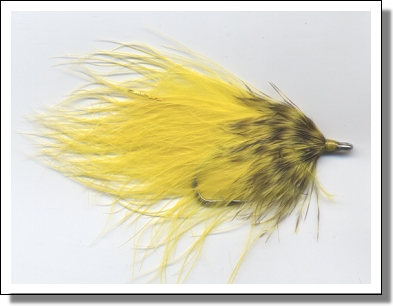
Ever since I started tying the Soft Hackle Streamer over 30 years ago, I've thought it just about the simplest streamer fly you can tie. In fact I often begin my fly tying classes with this fly for that reason: it is difficult to get wrong, even for the relative beginner. There is nothing to it once you understand the basics of tying. Tie in a little flash, wind on a marabou hackle and a folded mallard collar and--voila!--you have a simple and effective small baitfish imitation that can catch fish anywhere. Easy.
But experience has shown that while it is easy for me--and for some of my students-- it is a problem for many. The problem lies with the folded mallard collar (which I still consider indispensable for slimmer Soft Hackle Streamers). It is somewhat difficult for beginners to understand quickly the concept of "folding" hackle. Few possess the dexterity necessary to fold, twist, and wind this flat-stemmed feather all at the same time so that the feather barbs, when wound, surround the marabou wing with a neatly flowing veil and don't stand out willy-nilly like the legs of a fried spider.
A handy solution to this problem appeared a few years ago when I came in possession of numerous and wonderfully colored saddle patches and began to play around with them.
All the feathers on the saddle patch have their uses: the longer and better-formed feathers can be used for tying long Deceivers or flat-wings; the shorter and wider feathers for tarpon flies or small-to-medium traditional streamers; the long and fairly narrow feathers make excellent Wooly Bugger hackle; the downy marabou-like plumes near the base are great for tails on Wooly Buggers and Gartside Bugs.
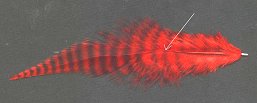 But
in the course of tying up some Soft Hackle Deceivers and flat-wings
I realized that I was overlooking some very valuable fly tying
material. I'm talking about those feathers found most often at
the lower end of a saddle patch in the area just above the schlappen
feathers. These feathers are odd-shaped or misshapen. They can
never be matched to another and are often discarded by the tyer
as useless. There are dozens of these quirky feathers on the average
saddle patch. Frugal Yankee that I am, this seemed a waste of
good material and I began to cast about for some possible uses.
It didn't take me long to see that the softer fibers (together
with some of the stiffer barbules higher up on the stem) could
be used for collaring not only standard streamers or tarpon flies
but also my own Soft Hackle Streamer.
But
in the course of tying up some Soft Hackle Deceivers and flat-wings
I realized that I was overlooking some very valuable fly tying
material. I'm talking about those feathers found most often at
the lower end of a saddle patch in the area just above the schlappen
feathers. These feathers are odd-shaped or misshapen. They can
never be matched to another and are often discarded by the tyer
as useless. There are dozens of these quirky feathers on the average
saddle patch. Frugal Yankee that I am, this seemed a waste of
good material and I began to cast about for some possible uses.
It didn't take me long to see that the softer fibers (together
with some of the stiffer barbules higher up on the stem) could
be used for collaring not only standard streamers or tarpon flies
but also my own Soft Hackle Streamer.
Experiments using this part of the feather for a collar on the Soft Hackle Streamer soon opened up many possibilities. Not only did it allow me to add a wide range of colors to my streamer palette but it also allowed me to add barring (when using grizzly or dyed grizzly) or mottling to the basic color of the marabou wing, as well as other unusual effects determined by the chosen feather. By using some of the stiffer barbules higher up on the feather stem in combination with the softer downy fibers, I was now able also to tie a Soft Hackle Streamer that was not only very attractive but more easily retained a fuller profile when wet and when moving in water. And best of all, it was easy. Certainly much easier than manipulating mallard.
The original Soft Hackle Streamer--with its collar of mallard--remains a standard streamer to use in both fresh and salt water, a "killing" and very simple small baitfish imitation. But if you want the "simple" to be "simpler," give the New Wave Soft Hackle Streamer a try. You'll be glad you did.
Tying the New Wave Soft Hackle Streamer
The pattern described below is a good example of a blended bi-colored New Wave Soft Hackle Streamer. It is one of my favorites for trout and smallmouth bass as well as for tarpon and snook. Other colors can be blended (that is, wound on together) to good effect. Among my other favorite color combinations are chartreuse/white, gray/white, black/olive, light olive/dark olive, black/brown. You may also want to try blending three or more colors together for unusual and effective results. To do so, simply follow the instructions below but wind on all three (or more)feathers together. To reduce bulk, you can strip away one half of one or more (or all) feathers before tying on and winding them in.
|
Hook: |
Salt Water: Daiichi 2546 or Mustad 34007 1/0-6. Fresh Water: Daiichi 2451 or Mustad 2406, sizes 2-6. |
|
Thread: |
6/0 Danville's, red. |
|
Tinsel: |
Gold holographic Flashabou. |
|
Hackle: |
Yellow and red blood marabou feathers tied in and wound together. |
|
Collar: |
Red-dyed grizzly lower saddle feather. |
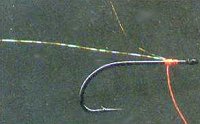 Tie in your thread approximately an eye-length behind the eye and wind eight or nine turns
toward the bend of the hook. Tie in one or two strands of flashabou so that length is just a little shorter than the hackle when wound on (this is optional; you may leave it longer than the wing if desired; it's more a matter of taste)..
Tie in your thread approximately an eye-length behind the eye and wind eight or nine turns
toward the bend of the hook. Tie in one or two strands of flashabou so that length is just a little shorter than the hackle when wound on (this is optional; you may leave it longer than the wing if desired; it's more a matter of taste)..
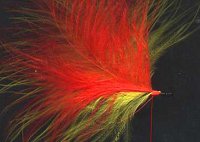 Select one red and one yellow blood marabou feather (of roughly equal width). At point where the stems taper quickly from thick to thin, snip off and discard thick lower portions.
Select one red and one yellow blood marabou feather (of roughly equal width). At point where the stems taper quickly from thick to thin, snip off and discard thick lower portions.
Place the red feather on top of the yellow feather concave side down and tie in both together by their butts. (The stronger color- -red-- should be placed on top of the weaker --yellow-- to achieve a more interesting and dramatic color distribution when wound on.)
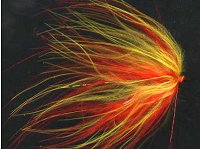 Using an E-Z mini-hook (better than hackle pliers), grasp the two feathers together by their stems up near the tips and wind on both together, taking one turn in front of the other and brushing the previous turn to the rear as you do. For double feathered flies such as this, two to three turns is usually sufficient. Fewer turns or more may also be taken, depending on desired level of fullness.
Using an E-Z mini-hook (better than hackle pliers), grasp the two feathers together by their stems up near the tips and wind on both together, taking one turn in front of the other and brushing the previous turn to the rear as you do. For double feathered flies such as this, two to three turns is usually sufficient. Fewer turns or more may also be taken, depending on desired level of fullness.
Trim excess when this step is completed With an eyelash groomer or similar tool, comb out any fibers (if any) that are "trapped" among the others so that your wing is fully and freely flowing.
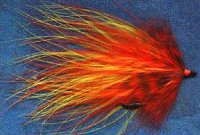 Pluck a feather from the lower end of a saddle patch (one with plenty of marabou-like fluff at its base). Snip feather at a point where the stem tapers sharply from thick to thin (see illustration) and just in front of the marabou wing tie this saddle feather in by what is now the butt. Wind this feather forward, taking one turn in front of another up to a point just behind the eye of the hook.
Pluck a feather from the lower end of a saddle patch (one with plenty of marabou-like fluff at its base). Snip feather at a point where the stem tapers sharply from thick to thin (see illustration) and just in front of the marabou wing tie this saddle feather in by what is now the butt. Wind this feather forward, taking one turn in front of another up to a point just behind the eye of the hook.
For a softer overall effect you may stop winding when the "marabou" portion of the feather is used up; for a somewhat stiffer collar--that will help to keep a broader streamer profile when fished-- you may continue winding to include some of the stiffer hackle barbs.
Trim excess material and tie off, forming a neat thread head. Cement the head and you're ready to fish it.






